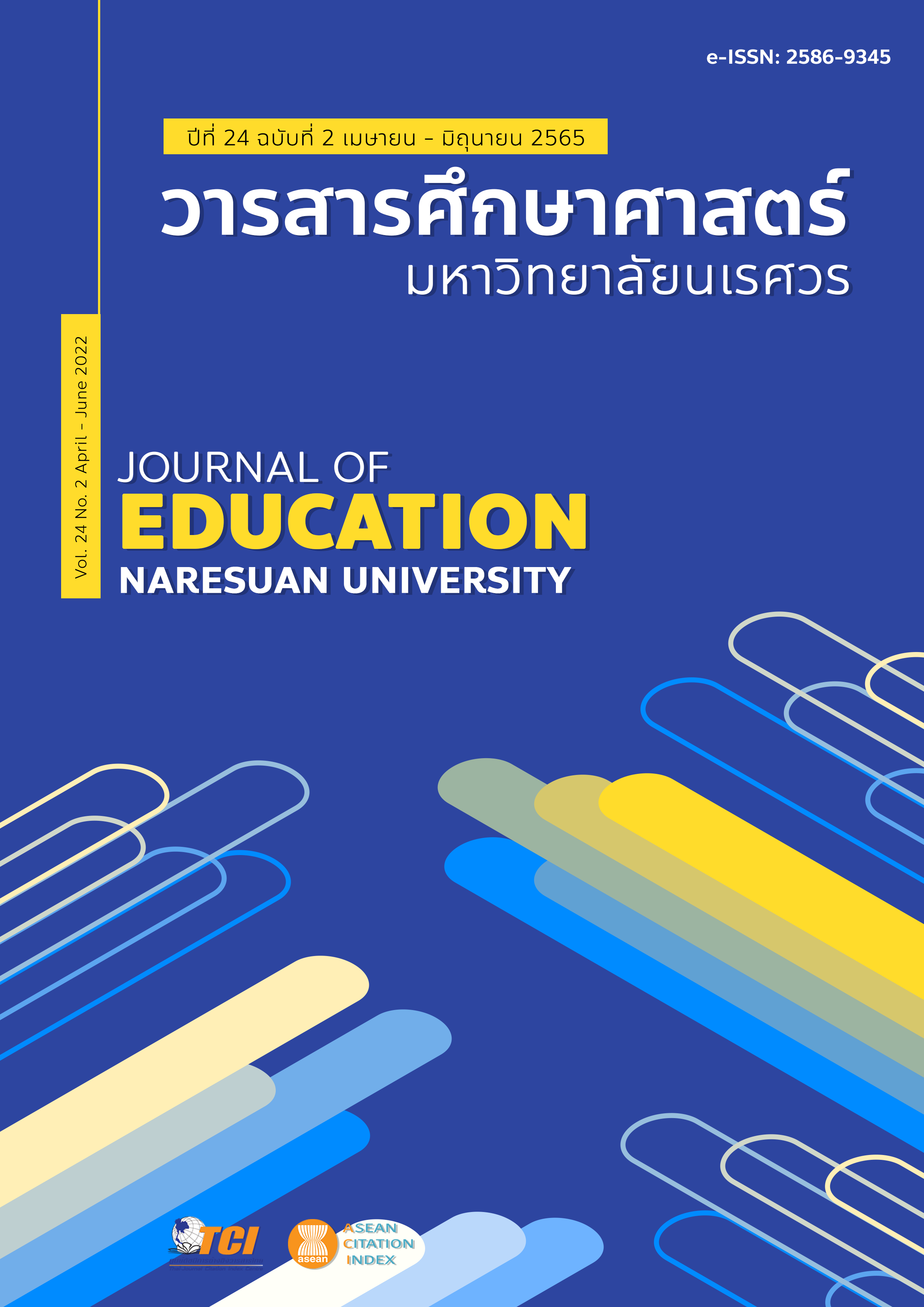การใช้แบบวัดบุคลิกภาพในกระบวนการคัดเลือกบุคคลในบริบททางการศึกษา USING PERSONALITY INVENTORIES IN THE EDUCATIONAL SELECTION
Main Article Content
บทคัดย่อ
การวัดทางจิตวิทยาโดยเฉพาะด้านบุคลิกภาพเริ่มเข้ามามีบทบาทในกระบวนการคัดเลือกอย่างต่อเนื่องทั้งในภาคการศึกษาและอุตสาหกรรมองค์กร แต่เมื่อนำมาปฏิบัติจริงยังประสบปัญหาการตอบที่ตั้งใจบิดเบือนโดยเฉพาะการตอบตามความปรารถนาของสังคมเพื่อให้ตนเองผ่านการคัดเลือก จึงเริ่มมีการศึกษาและนำเสนอแนวทางในการป้องกันและแก้ไขปัญหาดังกล่าวอย่างหลากหลาย โดยในที่นี้การสร้างแบบวัดในรูปแบบบังคับเลือกเป็นหนึ่งในแนวทางที่มีผลการศึกษาจำนวนมาก ยืนยันถึงประสิทธิผลในการป้องกันการตอบแบบวัดอย่างบิดเบือน อย่างไรก็ตาม การใช้แบบวัดรูปแบบบังคับเลือกโดยใช้รูปแบบการคิดค่าคะแนนแบบดั้งเดิมยังก่อให้เกิดข้อจำกัดเกี่ยวกับปัญหาการไม่สามารถนำผลคะแนนไปใช้วัดความแตกต่างระหว่างบุคคลได้อย่างถูกต้อง ในระยะต่อมาจึงเริ่มมีการนำทฤษฎีการตอบสนองข้อสอบเข้ามาประยุกต์ใช้ในการคิดค่าคะแนนของแบบวัดรูปแบบบังคับเลือกเพื่อให้สามารถนำแบบวัดรูปแบบบังคับเลือกไปใช้ในกระบวนการคัดเลือกได้จริงในทางปฏิบัติ
Article Details

This work is licensed under a Creative Commons Attribution-NonCommercial-NoDerivatives 4.0 International License.
เจ้าของบทความมิได้คัดลอก หรือละเมิดลิขสิทธิ์ของผู้ใด หากเกิดการละเมิดลิขสิทธิ์ ไม่ว่าวิธีใด หรือการฟ้องร้องไม่ว่ากรณีใด ๆ ที่อาจเกิดขึ้นได้ กองบรรณาธิการวารสารศึกษาศาสตร์ ไม่มีส่วนเกี่ยวข้องทั้งสิ้น ให้เป็นสิทธิ์ของเจ้าของบทความที่จะดำเนินการ
References
Brown, A., & Olivares, A. M. (2011). Item Response Modeling of forced-choice questionnaires, Educational and Psychological Measurement, 71(3), 460-502.
Brown, A. (2015). Personality assessment forced choice. In Wright, J.D., ed. International Encyclopedia of the Social and Behavioral Sciences. Elsevier.
Cao, M. (2016). Examining the fixability of forced-choice individual differences measures (Doctoral dissertation). Illinois: University of Illinois.
Clemans, W. V. (1966). An analytical and empirical examination of some properties of ipsative
measures. Richmond, VA: Psychometric Society.
Clemans, W. V. (1967). An analytical and empirical examination of some properties of ipsative measures. Richmond, VA: Psychometric Society.
Jantawarn, S. (2013). Development of a socially desirable responding scale of Thai undergraduate students (Doctoral dissertation). Bangkok: Chulalongkorn University. [in Thai]
Kaplan, R. M., & Saccuzzo, D. P. (2009) Psychological testing: Principles, applications, and issues. Belmont, CA: Wadsworth Cengage Learning,
Kline, P. (2000). The handbook of psychological testing (2nd ed.). London: United Kingdom Routledge.
Lee, P., Lee, S., & Stark, S. (2018). Examining validity evidence for multidimensional forced choice measures with different scoring approaches. Personality and Individual Differences, 123, 229-235. 10.1016/j.paid.2017.11.031.
Mueller-Hanson, R., Heggestad, E. D., & Thornton, G. C. (2003). Faking and selection: Considering the use of personality from select-in and select-out perspectives. Journal of Applied Psychology, 88(2), 348–355.
Hontangas, P. D., Torre, J. D., Ponsoda, V., Leenen, I., Morillo, D., & Abad, F. J. (2015). Comparing traditional and IRT scoring of forced-choice tests. Applied Psychological Measurement, 39(8), 598-612.
Salgado, J. F., Anderson, N., & Tauriz, G. (2015). The validity of ipsative and quasi-ipsative forced-choice personality inventories for different occupational groups: A comprehensive meta-analysis. Journal of Occupational and Organizational Psychology, 88(4), 797–834.
Stark, S., Chernyshenko, O. S., Drasgow, F., & White, A. (2012). Adaptive Testing with Multidimensional Pairwise Preference Items: Improving the efficiency of personality and other noncognitive assessment. Organizational Research Methods, 15(3), 463-487.
Stark, S., Chernyshenko, O. S., Drasgow, F., Nye, D., White, A., Heffner, T., & Farmer, L. (2014). From ABLE to TAPAS: A new generation of personality tests to support military selection and classification decisions. Military Psychology, 26(3), 153-164.
Stark, S., Chernyshenko, O. S., & Drasgow, F. (2005). An IRT approach to constructing and scoring pairwise preference items involving stimuli on different dimensions: An application to the problem of faking in personality assessment. Applied Psychological Measurement, 29, 184- 201.
Stark, S., Chernyshenko, O. S., & Drasgow, F., & Williams, B. A. (2006). Item responding in personality assessment: Should ideal point methods be considered for scale development and scoring? Journal of Applied Psychology, 91, 25-3.
Touze, P. (2005). Personality and prediction of performance in the workplace. Personality and performance, 68(1), 37-53.
Wang, W. C., Qiu, X. L., Chen, C. W., Ro, S., & Jin, K. Y. (2017). Item Response Theory Models for Ipsative Tests with Multidimensional Pairwise. Comparison Items. Applied Psychological Measurement, 41(8), 600–613.
Zhang, B. (2018). Though forced, still valid: Psychometric equivalence of forced-choice and single-statement measures (Doctoral dissertation). Illinois: University of Illinois.

